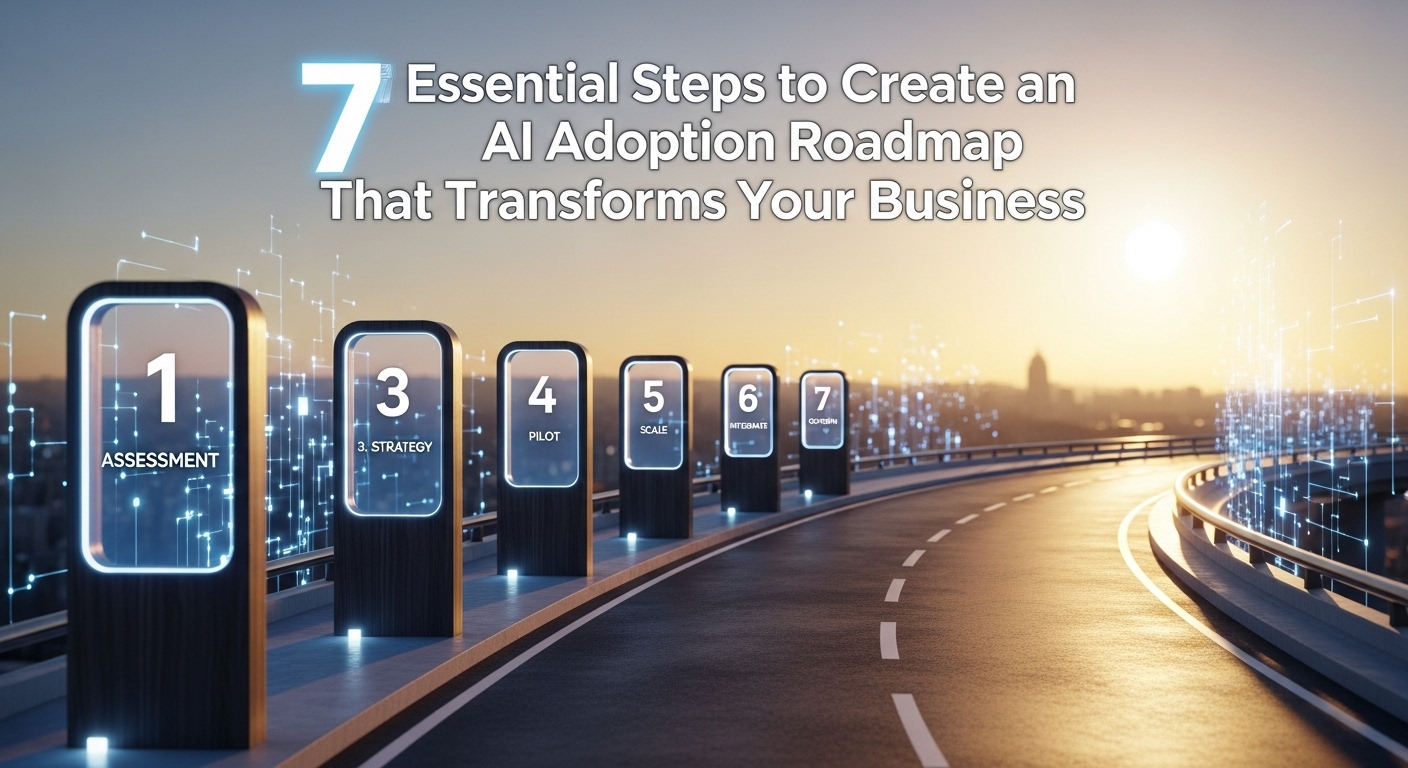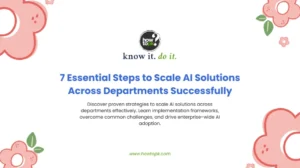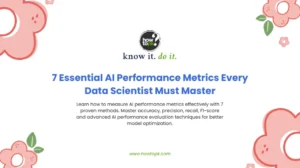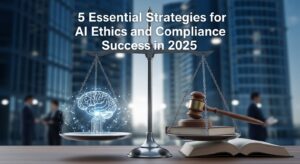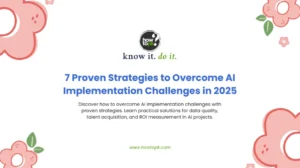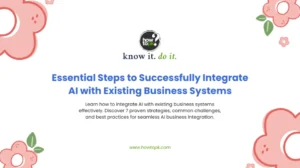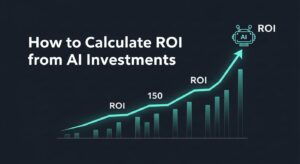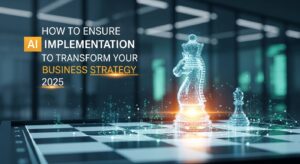Creating an AI adoption roadmap is no longer optional for businesses seeking competitive advantage—it’s essential. With artificial intelligence transforming industries at an unprecedented pace, organizations that fail to develop a strategic approach to AI integration risk falling behind their more prepared competitors.
But here’s the critical question: Where do you begin when the AI landscape feels overwhelming and the stakes are high?
This comprehensive guide will walk you through seven essential steps to create an AI adoption roadmap that drives real business value while minimizing risks and maximizing return on investment.
Why Your Business Needs an AI Adoption Roadmap
Before diving into the how-to, let’s examine why a structured AI adoption roadmap matters more than ever in 2025.
Recent studies show that companies with formal AI strategies are 2.3 times more likely to achieve significant business impact from their AI initiatives. Without a roadmap, organizations often fall into common traps: implementing AI for the sake of technology rather than business value, lacking proper data infrastructure, or failing to prepare their workforce for AI-driven changes.
An effective AI adoption roadmap serves as your strategic blueprint, guiding decision-making from initial assessment through full-scale implementation. It helps align stakeholders, allocate resources efficiently, and establish measurable success metrics that matter to your business.
Step 1: Assess Your Current AI Readiness
The foundation of any successful AI adoption roadmap begins with honest self-assessment. Think of this as taking inventory of your organization’s current capabilities and identifying gaps that need addressing.
Data Infrastructure Evaluation
Your AI initiatives will only be as strong as the data that powers them. Conduct a thorough audit of your existing data infrastructure:
- Data Quality: How clean, consistent, and reliable is your current data?
- Data Accessibility: Can different departments easily access the data they need?
- Data Governance: Do you have clear policies for data usage, privacy, and compliance?
- Storage and Processing Capacity: Can your current systems handle the computational demands of AI applications?
Technical Capabilities Assessment
Evaluate your organization’s technical readiness across several dimensions:
Assessment Area | Key Questions |
IT Infrastructure | Can current systems support AI workloads? |
Security Framework | Are cybersecurity measures AI-ready? |
Integration Capabilities | How easily can new AI tools integrate with existing systems? |
Cloud Readiness | Is your organization prepared for cloud-based AI solutions? |
Organizational Readiness
Consider the human element of AI adoption. Survey key stakeholders to understand:
- Current AI knowledge and comfort levels across departments
- Leadership commitment to AI transformation
- Change management capabilities
- Budget allocation flexibility for AI initiatives
For comprehensive assessment tools, organizations like McKinsey & Company provide valuable AI readiness frameworks that can guide your evaluation process.
Step 2: Define Clear AI Objectives and Business Goals
Once you understand your starting point, the next crucial step in your AI adoption roadmap involves setting specific, measurable objectives that align with your broader business strategy.
Identify High-Impact Use Cases
Rather than trying to implement AI everywhere at once, focus on identifying 3-5 high-impact use cases that can deliver measurable business value. Consider these categories:
Customer Experience Enhancement
- Personalized product recommendations
- Intelligent chatbots for customer service
- Predictive customer behavior analysis
Operational Efficiency
- Automated data entry and processing
- Predictive maintenance for equipment
- Supply chain optimization
Decision Support
- Advanced analytics and business intelligence
- Risk assessment and fraud detection
- Market trend analysis and forecasting
Set SMART AI Goals
Transform your identified use cases into SMART (Specific, Measurable, Achievable, Relevant, Time-bound) goals. For example:
Instead of: “Improve customer service with AI” Write: “Reduce customer service response time by 40% within 6 months by implementing an AI-powered chatbot that handles 60% of routine inquiries”
Establish Success Metrics
Define both quantitative and qualitative metrics for measuring AI adoption success:
- Financial Metrics: ROI, cost savings, revenue increase
- Operational Metrics: Efficiency gains, error reduction, processing speed
- Customer Metrics: Satisfaction scores, retention rates, engagement levels
- Employee Metrics: Job satisfaction, productivity, skill development
Step 3: Prioritize AI Initiatives Based on Value and Complexity
With your objectives defined, you need to strategically prioritize initiatives to maximize early wins while building toward more complex implementations.
The AI Value-Complexity Matrix
Create a simple 2×2 matrix plotting your identified AI initiatives based on:
- Y-axis: Business Value (High to Low)
- X-axis: Implementation Complexity (Low to High)
This visualization helps categorize initiatives into four quadrants:
- Quick Wins (High Value, Low Complexity): Start here for early momentum
- Strategic Projects (High Value, High Complexity): Plan for medium-term implementation
- Fill-ins (Low Value, Low Complexity): Consider for later phases
- Questionable (Low Value, High Complexity): Avoid or significantly modify
Consider Implementation Dependencies
Some AI initiatives naturally build upon others. Map out these dependencies to create a logical sequence. For instance, improving data quality might be a prerequisite for advanced analytics, which then enables more sophisticated AI applications.
Resource Allocation Strategy
Develop a phased approach that balances ambition with realism:
- Phase 1 (0-6 months): Quick wins and foundation building
- Phase 2 (6-18 months): Medium-complexity initiatives
- Phase 3 (18+ months): Strategic, high-complexity projects
Step 4: Build Your AI Technology Stack
Your AI adoption roadmap must include a clear technology strategy that supports your identified use cases while remaining flexible for future needs.
Core Technology Components
A robust AI technology stack typically includes:
Data Management Layer
- Data warehouses or lakes for storage
- ETL/ELT tools for data processing
- Data quality management systems
AI/ML Platform Layer
- Machine learning frameworks (TensorFlow, PyTorch)
- AutoML platforms for citizen data scientists
- Model management and MLOps tools
Application Layer
- APIs for AI service integration
- User interfaces for AI-powered applications
- Integration middleware
Infrastructure Layer
- Cloud computing resources (AWS, Azure, Google Cloud)
- Edge computing capabilities where needed
- Security and monitoring tools
Build vs. Buy Decisions
For each technology component, evaluate whether to build internally, purchase commercial solutions, or use cloud-based services. Consider factors like:
- Internal technical expertise
- Customization requirements
- Total cost of ownership
- Time to implementation
- Scalability needs
Leading cloud providers like Amazon Web Services, Microsoft Azure, and Google Cloud AI offer comprehensive AI platforms that can accelerate implementation while reducing infrastructure complexity.
Step 5: Develop Your AI Talent Strategy
Technology alone doesn’t drive successful AI adoption—you need the right people with the right skills to implement and manage your AI initiatives effectively.
Current Workforce Assessment
Analyze your existing team’s capabilities across key AI-related skill areas:
- Technical Skills: Programming, data science, machine learning
- Domain Expertise: Deep understanding of business processes and requirements
- Analytical Skills: Statistical analysis, critical thinking, problem-solving
- Communication Skills: Ability to translate between technical and business teams
AI Talent Acquisition Strategy
Most organizations will need to hire some specialized AI talent. Key roles to consider include:
- Data Scientists: Build and optimize machine learning models
- ML Engineers: Deploy and maintain AI systems in production
- AI Product Managers: Bridge business requirements and technical implementation
- Data Engineers: Design and maintain data infrastructure
Upskilling Existing Employees
Rather than hiring for every AI role, invest in training your current workforce. This approach offers several advantages:
- Employees already understand your business context
- Lower turnover risk compared to external hires
- Improved change management and adoption
- Cost-effective skill development
Create learning paths that combine online courses, workshops, and hands-on projects. Platforms like Coursera for Business and Udacity for Enterprise offer comprehensive AI and machine learning curricula designed for workplace learning.
Step 6: Address Data Governance and Compliance
A successful AI adoption roadmap must prioritize data governance and regulatory compliance from the outset, not as an afterthought.
Establish Data Governance Framework
Your data governance framework should address:
Data Quality Standards
- Accuracy requirements for different data types
- Completeness thresholds for AI model training
- Consistency rules across data sources
- Timeliness requirements for real-time applications
Access Controls and Security
- Role-based access to sensitive data
- Encryption standards for data at rest and in transit
- Audit trails for data access and modifications
- Backup and disaster recovery procedures
Privacy and Ethical AI Guidelines
- Data anonymization and pseudonymization practices
- Consent management for customer data usage
- Algorithmic bias detection and mitigation
- Transparent AI decision-making processes
Regulatory Compliance Considerations
Stay informed about evolving AI regulations in your industry and geography. Key areas include:
- GDPR and Data Privacy: Ensure AI systems comply with data protection regulations
- Industry-Specific Requirements: Healthcare (HIPAA), Finance (SOX), etc.
- Emerging AI Legislation: EU AI Act, proposed US federal AI regulations
- Ethical AI Standards: IEEE, ISO, and industry association guidelines
Implement AI Ethics Board
Consider establishing a cross-functional AI ethics committee to:
- Review AI initiatives for potential ethical concerns
- Develop organizational AI ethics principles
- Monitor AI system outcomes for unintended consequences
- Provide guidance on controversial AI applications
Step 7: Create Implementation Timeline and Milestones
The final step in your AI adoption roadmap involves creating a detailed timeline with specific milestones, dependencies, and success criteria.
Phase-Based Implementation Approach
Structure your timeline around distinct phases, each building upon previous achievements:
Foundation Phase (Months 1-6)
- Complete data infrastructure improvements
- Establish governance framework
- Begin team training and hiring
- Launch first quick-win AI projects
Expansion Phase (Months 7-18)
- Deploy medium-complexity AI initiatives
- Integrate AI tools across multiple departments
- Develop internal AI expertise
- Scale successful pilot projects
Maturation Phase (Months 19+)
- Implement advanced AI capabilities
- Optimize and refine existing AI systems
- Explore emerging AI technologies
- Share learnings and best practices
Key Milestone Framework
For each phase, define specific milestones with clear success criteria:
Milestone | Details |
Data Quality Baseline | Success Criteria: 95% data accuracy achieved Timeline: Month 3 Owner: Data Engineering Team |
First AI Pilot Launch | Success Criteria: Chatbot handling 50% of inquiries Timeline: Month 4 Owner: Customer Service Team |
Team Training Completion | Success Criteria: 80% of identified staff complete core AI courses Timeline: Month 6 Owner: HR and Training Teams |
ROI Demonstration | Success Criteria: 15% efficiency gain in pilot areas Timeline: Month 8 Owner: Project Management Office |
Risk Management and Contingency Planning
Identify potential risks that could derail your AI adoption timeline:
Technical Risks
- Data quality issues
- Integration challenges
- Performance problems
Organizational Risks
- Resistance to change
- Skills gaps
- Budget constraints
External Risks
- Regulatory changes
- Technology evolution
- Competitive pressures
For each identified risk, develop contingency plans and assign responsibility for monitoring and mitigation.
Measuring Success and Continuous Improvement
Your AI adoption roadmap shouldn’t end with initial implementation—it requires ongoing measurement, optimization, and evolution.
Regular Assessment Checkpoints
Schedule quarterly reviews to assess progress against your defined metrics:
- Quantitative Performance: Are you meeting numerical targets for efficiency, accuracy, and ROI?
- Qualitative Feedback: How are employees and customers responding to AI implementations?
- Technical Performance: Are AI systems performing reliably and meeting service level agreements?
- Strategic Alignment: Do current AI initiatives still align with evolving business priorities?
Continuous Learning and Adaptation
The AI landscape evolves rapidly, so your roadmap must remain flexible:
- Stay informed about emerging AI technologies and capabilities
- Regularly reassess your technology stack for optimization opportunities
- Gather feedback from users and stakeholders for improvement insights
- Adjust priorities based on changing business needs and market conditions
Scale Successful Initiatives
When AI projects demonstrate clear value, develop strategies to scale them across the organization:
- Document best practices and lessons learned
- Create templates and frameworks for similar implementations
- Train additional teams on successful AI tools and processes
- Integrate proven AI capabilities into standard operating procedures
Common Pitfalls to Avoid in AI Adoption
Learning from others’ mistakes can accelerate your AI adoption success. Here are the most common pitfalls organizations encounter:
- Starting Without Clear Business Objectives: Many organizations begin AI initiatives with impressive technology but unclear business purpose. Always start with business problems, not technology solutions.
- Underestimating Data Requirements: AI systems require high-quality, well-organized data. Don’t assume your existing data infrastructure is AI-ready without thorough assessment.
- Ignoring Change Management: Technical implementation is often easier than organizational change. Invest adequately in change management, training, and communication.
- Trying to Do Everything at Once: AI adoption works best with focused, phased approaches rather than attempting organization-wide transformation simultaneously.
- Neglecting Ethical and Compliance Considerations: Address governance, ethics, and compliance from the beginning rather than as an afterthought to avoid costly retrofitting.
Conclusion: Your AI Adoption Roadmap as a Strategic Advantage
Creating an effective AI adoption roadmap requires thoughtful planning, stakeholder alignment, and commitment to continuous improvement. By following the seven steps outlined in this guide—assessing readiness, defining objectives, prioritizing initiatives, building technology infrastructure, developing talent, addressing governance, and creating detailed implementation timelines—you’ll position your organization for AI success.
Remember that your AI adoption roadmap is a living document that should evolve with your business needs, technological capabilities, and market conditions. The organizations that will thrive in the AI-driven future are those that approach AI adoption strategically, systematically, and with a commitment to ongoing learning and adaptation.
The question isn’t whether your organization will adopt AI, it’s how quickly and effectively you can do so while maintaining your competitive edge. Start building your AI adoption roadmap today, and transform your business for the intelligent future ahead.

